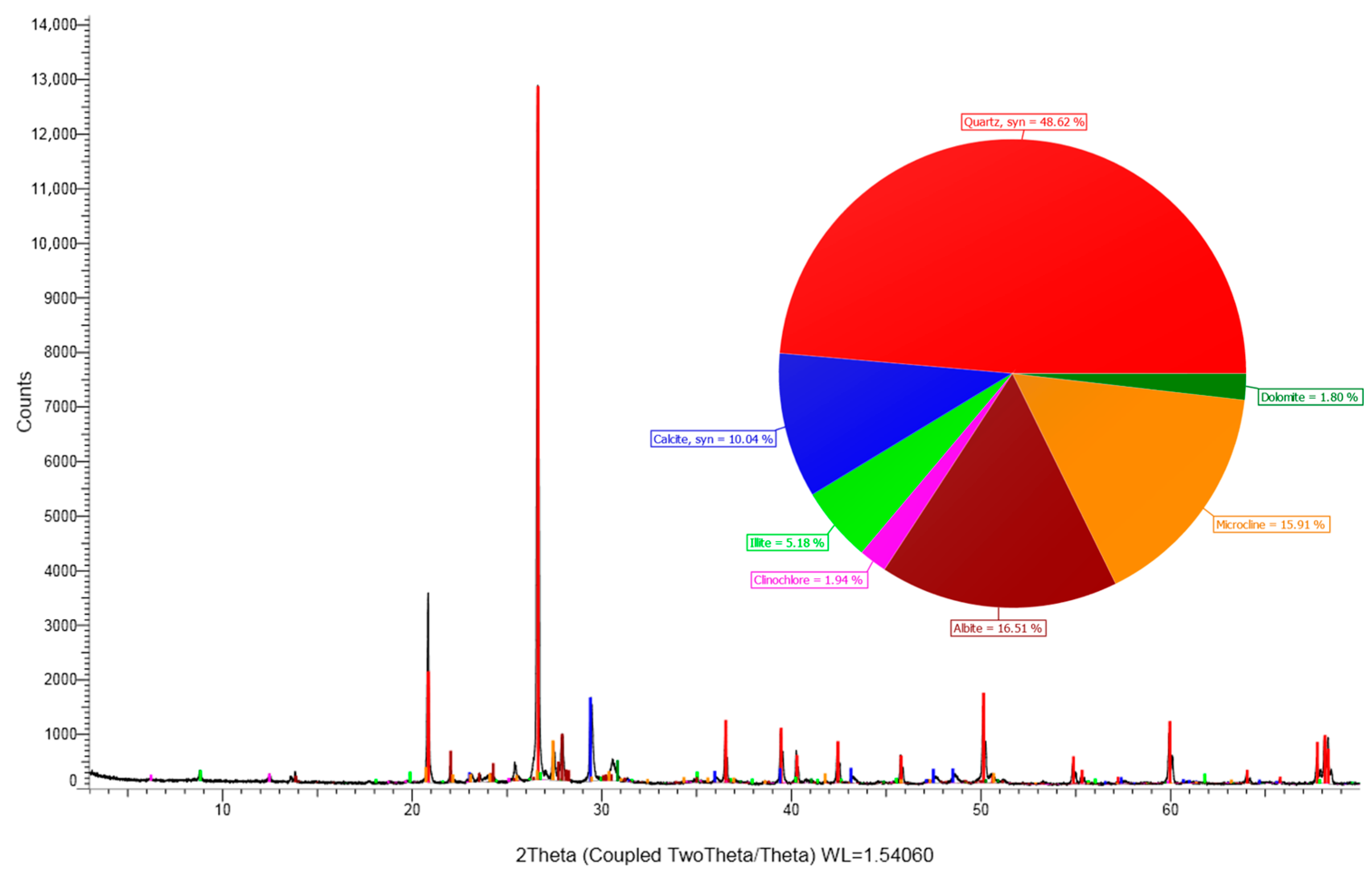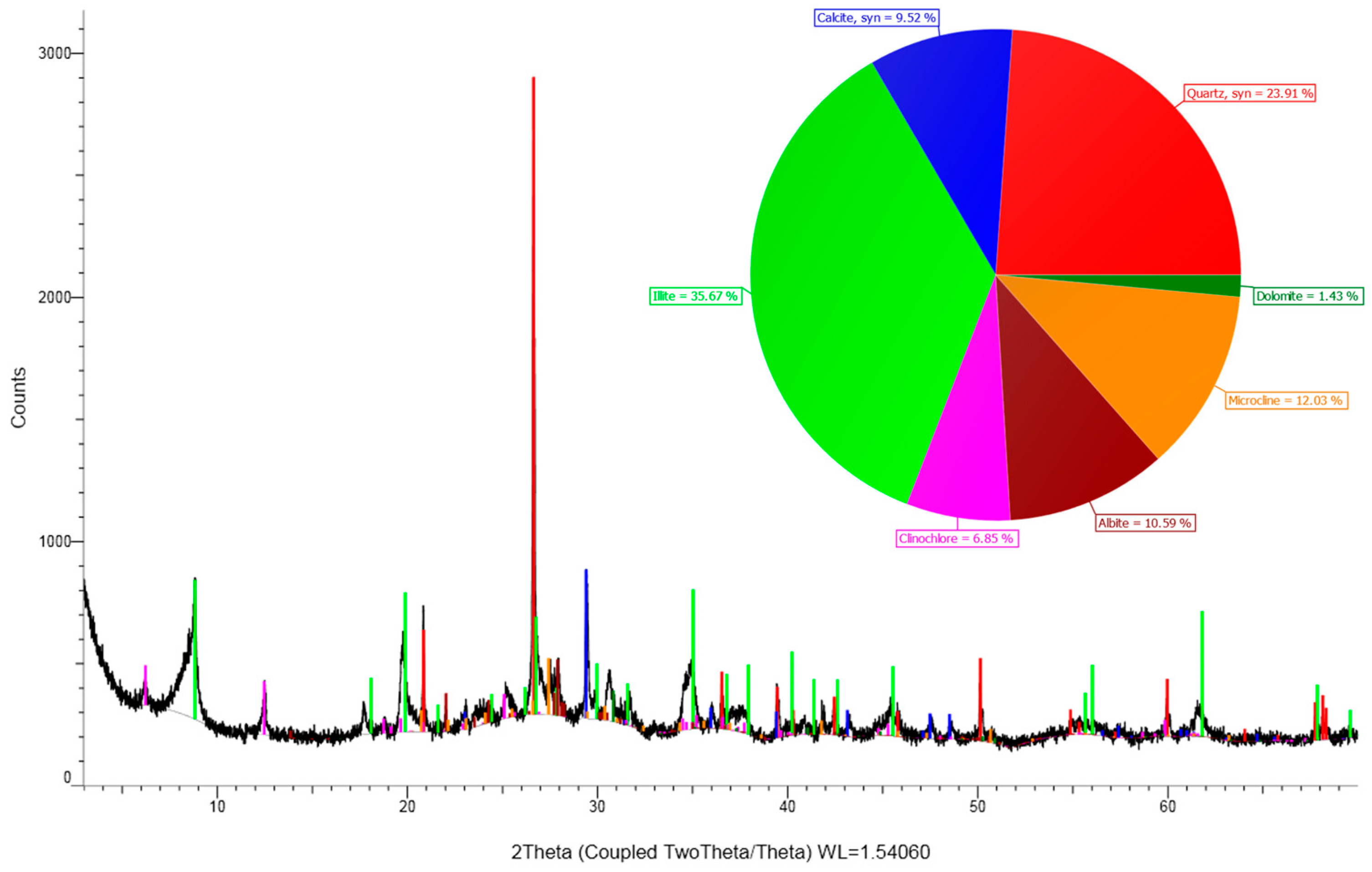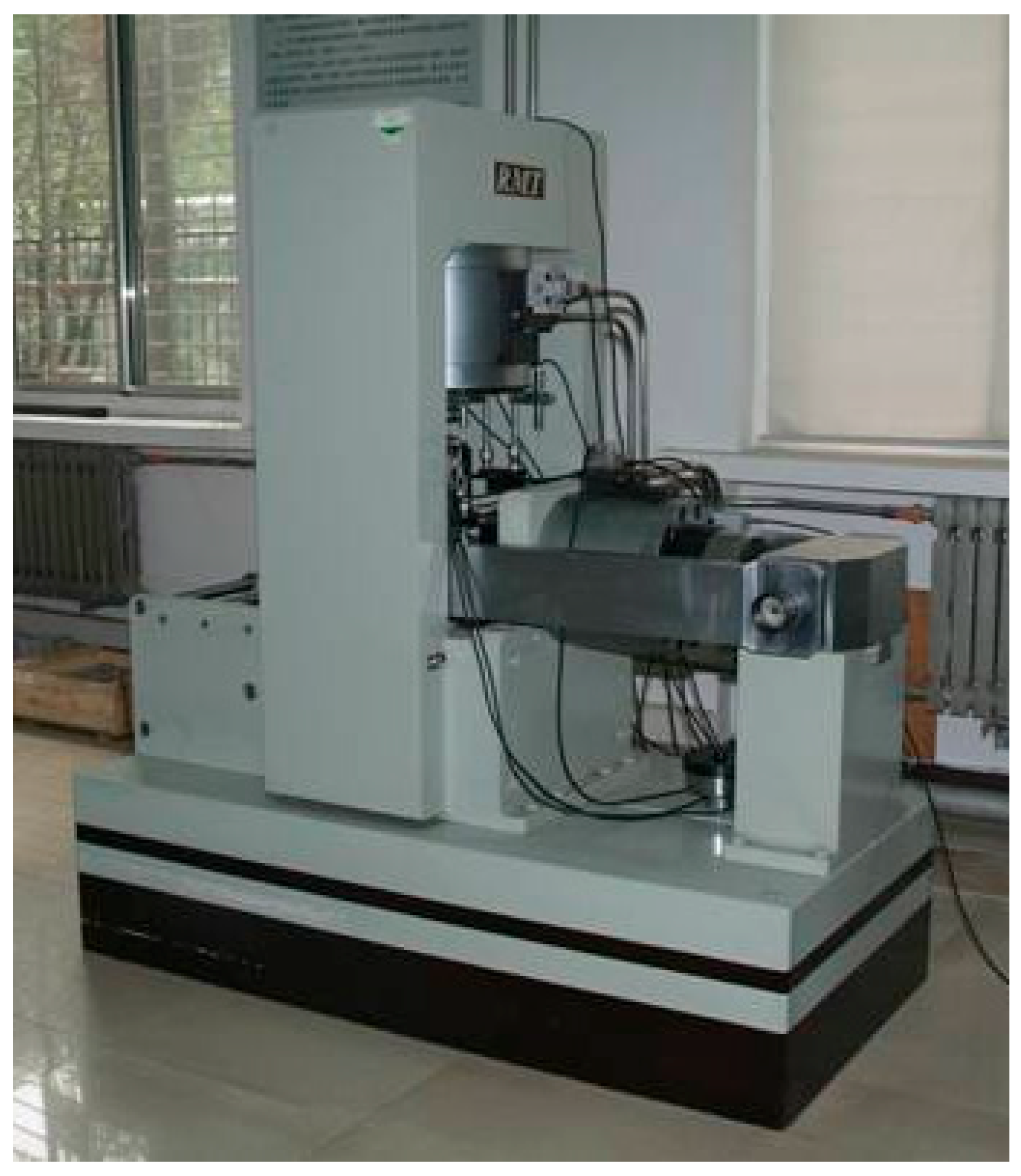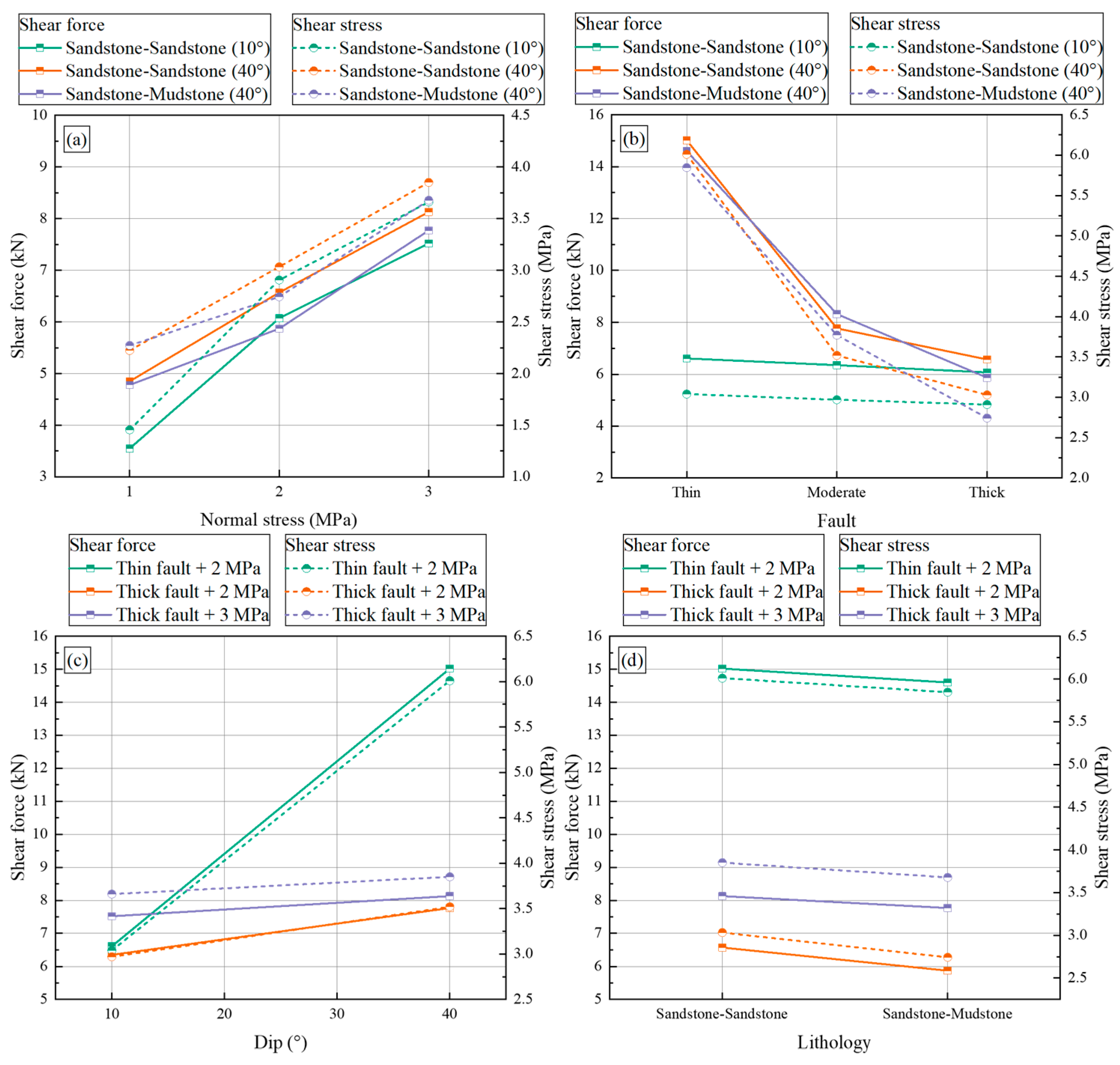Experimental Investigation on the Shear Behavior of Different Faults in Depleted Gas Storage Reservoirs
Abstract
1. Introduction
2. Experimental Designs
2.1. Sample Preparation
- (1)
- Generating the fault plane with specific angle by python.
- (2)
- Carving sandstone (mudstone) according to the fault plane using a high-precision carving machine (Precision: ±0.02/300 mm).
- (3)
- Applying the prepared fault filling evenly to the fault plane.
- (4)
- Putting the upper and lower parts together and maintaining a vertical pressure (4 MPa) on the specimen for 2 days [30] for consolidation and maintenance pending the experiment.
2.2. Experimental Factors
2.3. Test Equipment
3. Results Analysis
3.1. Force-Displacement Curves
3.2. Mechanical Characteristics
3.3. Shear Feature
3.3.1. Shear Morphology
3.3.2. Roughness and Fractal Dimension
4. Discussion
5. Conclusions
- (1)
- A novel testing method was developed for finely engraving faults on downhole cores, allowing for the simulation of real reservoir conditions.
- (2)
- Normal stress substantially increases shear strength and the critical stress required for crack initiation by reinforcing frictional constraints along fracture surfaces. However, the accompanying changes in fracture morphology may generate potential seepage pathways, underscoring its dual effect on fault stability.
- (3)
- Increased fault mud filling promotes localized plastic deformation and reduces overall shear strength. Faults with thin mud layers exhibit higher critical crack initiation stresses, whereas those with thicker fillings demonstrate a degree of self-sealing potential.
- (4)
- For equal amounts of fault mud, the shear strength of fault specimens at a 40° angle exceeds that of specimens at a 10° angle. This implies that a greater degree of fault undulation corresponds to a higher critical slip initiation stress, reducing the likelihood of fault slip and enhancing stability.
- (5)
- Compared to sandstone–sandstone combinations, the shear strength of faults in sandstone–mudstone combinations is significantly lower. Mudstone’s weaker mechanical qualities are the main cause of this reduction. It experiences plastic deformation and fails preferentially during shearing, acting as the dominant weak plane controlling fault slip. Therefore, rather than the higher frictional resistance typical of sandstone–sandstone interfaces, the shear strength of these faults is primarily controlled by the mudstone’s intrinsic low cohesion and internal friction angle.
Author Contributions
Funding
Institutional Review Board Statement
Informed Consent Statement
Data Availability Statement
Acknowledgments
Conflicts of Interest
References
- Al-Shafi, M.; Massarweh, O.; Abushaikha, A.S.; Bicer, Y. A Review on Underground Gas Storage Systems: Natural Gas, Hydrogen and Carbon Sequestration. Energy Rep. 2023, 9, 6251–6266. [Google Scholar] [CrossRef]
- Liu, H.; Yang, C.; Liu, J.; Hou, Z.; Xie, Y.; Shi, X. An Overview of Underground Energy Storage in Porous Media and Development in China. Gas Sci. Eng. 2023, 117, 205079. [Google Scholar] [CrossRef]
- Molíková, A.; Vítězová, M.; Vítěz, T.; Buriánková, I.; Huber, H.; Dengler, L.; Hanišáková, N.; Onderka, V.; Urbanová, I. Underground Gas Storage as a Promising Natural Methane Bioreactor and Reservoir? J. Energy Storage 2022, 47, 103631. [Google Scholar] [CrossRef]
- Wang, X.; Economides, M.J. Purposefully Built Underground Natural Gas Storage. J. Nat. Gas Sci. Eng. 2012, 9, 130–137. [Google Scholar] [CrossRef]
- Sambo, C.; Dudun, A.; Samuel, S.A.; Esenenjor, P.; Muhammed, N.S.; Haq, B. A Review on Worldwide Underground Hydrogen Storage Operating and Potential Fields. Int. J. Hydrogen Energy 2022, 47, 22840–22880. [Google Scholar] [CrossRef]
- Du, X.; Liu, M.; Qiu, S.; Wu, J.; Meng, X. Implications of the European Gas Market for the Long-Term Construction of Underground Gas Storage in China. Energy Sci. Eng. 2023, 11, 2137–2155. [Google Scholar] [CrossRef]
- Thiyagarajan, S.R.; Emadi, H.; Hussain, A.; Patange, P.; Watson, M. A Comprehensive Review of the Mechanisms and Efficiency of Underground Hydrogen Storage. J. Energy Storage 2022, 51, 104490. [Google Scholar] [CrossRef]
- Bakhtiari, M.; Shad, S.; Zivar, D.; Razaghi, N. Coupled Hydro-Mechanical Analysis of Underground Gas Storage at Sarajeh Field, Qom Formation, Iran. J. Nat. Gas Sci. Eng. 2021, 92, 103996. [Google Scholar] [CrossRef]
- Zhang, S.; Shi, L.; Jia, D. An Uncertainty Quantitative Model of Wellbore Failure Risk for Underground Gas Storage in Depleted Gas Reservoir During the Construction Process. J. Energy Storage 2023, 57, 106144. [Google Scholar] [CrossRef]
- Liu, C.; Zhang, F.; Wang, Q.; Wang, B.; Zhang, Q.; Xu, B. Evaluation of Fault Stability and Seismic Potential for Hutubi Underground Gas Storage Due to Seasonal Injection and Extraction. Undergr. Space 2023, 13, 74–85. [Google Scholar] [CrossRef]
- Zhao, W.; An, M.; Dal Zilio, L.; Zhao, L.; Zhu, H.; Shen, X.; Gan, Q.; Zhang, F.; Elsworth, D. Coupled Evolution of Seismicity and Permeability in Fault Zones. Commun. Earth Environ. 2025, 6, 918. [Google Scholar] [CrossRef]
- Saffou, E.; Gholami, R.; Raza, A.; Mahmoud, M.; Manzi, M.S.D.; Durrheim, R. A One-Way Coupled Geomechanical Model for CO2 Storage in Faulted Depleted Gas Reservoirs. Gas Sci. Eng. 2023, 120, 205143. [Google Scholar] [CrossRef]
- Yu, J. Surface Subsidence Induced by Salt Cavern Gas Storage and Its Impact on Railway Safety: Numerical Simulation and Fuzzy Evaluation. Results Eng. 2025, 26, 105331. [Google Scholar] [CrossRef]
- Lackey, G.; Mundia-Howe, M.; Pekney, N.J. Underground Natural Gas Storage Facility Operations and Well Leakage Events in the United States. Geoenergy Sci. Eng. 2024, 234, 212630. [Google Scholar] [CrossRef]
- Yang, S.; Hu, S.; Qi, Z.; Li, J.; Yan, W.; Huang, X.; Ao, X.; Yuan, Y. Stability Evaluation of Fault in Hydrocarbon Reservoir-Based Underground Gas Storage: A Case Study of W Gas Storage. Fuel 2024, 357, 129657. [Google Scholar] [CrossRef]
- Zhao, Z.; Cui, J.; Liu, H.; Jia, S.; Liu, C.; Xi, Z.; Wen, C. Geo-Mechanical Evaluation of a Proposed Gas Storage in Aquifer Anticline Trap with Deep Fault. Bull. Eng. Geol. Environ. 2024, 83, 102. [Google Scholar] [CrossRef]
- Chang, K.W.; Segall, P. Injection-Induced Seismicity on Basement Faults Including Poroelastic Stressing. J. Geophys. Res. Solid Earth 2016, 121, 2708–2726. [Google Scholar] [CrossRef]
- Fan, Z.; Eichhubl, P.; Newell, P. Basement Fault Reactivation by Fluid Injection Into Sedimentary Reservoirs: Poroelastic Effects. J. Geophys. Res. Solid Earth 2019, 124, 7354–7369. [Google Scholar] [CrossRef]
- Peter, E.; Fan, Z.; Zhu, C. Basement Fault Reactivation by Fluid Injection into Sedimentary Reservoirs; ADS: Cambridge, MA, USA, 2017; p. 10679. [Google Scholar]
- Lv, Y.; Yuan, C.; Zhu, X.; Gan, Q.; Li, H. THMD Analysis of Fluid Injection-Induced Fault Reactivation and Slip in EGS. Geothermics 2022, 99, 102303. [Google Scholar] [CrossRef]
- Benfu, Y.; Xiangzhen, Y.; Henglin, Y.; Zhiqian, X.; Xiujuan, Y.; Yaorong, F. Non-Probabilistic Reliability Analysis of Dead Fault Slip in Underground Gas Storage Based on Convex Model. Acta Pet. Sin. 2014, 35, 577. [Google Scholar] [CrossRef]
- Ban, S.; Liu, H.; Mao, H.; Shi, X.; Qiu, X.; Liu, M.; Min, Z.; Song, Y.; Wei, X. Numerical Tracking of Natural Gas Migration in Underground Gas Storage with Multilayered Sandstone and Fault-Bearing Caprocks. Energies 2023, 16, 4936. [Google Scholar] [CrossRef]
- Gan, Q.; Lei, Q. Induced Fault Reactivation by Thermal Perturbation in Enhanced Geothermal Systems. Geothermics 2020, 86, 101814. [Google Scholar] [CrossRef]
- Jacquey, A.B.; Cacace, M.; Blöcher, G.; Scheck-Wenderoth, M. Numerical Investigation of Thermoelastic Effects on Fault Slip Tendency during Injection and Production of Geothermal Fluids. Energy Procedia 2015, 76, 311–320. [Google Scholar] [CrossRef]
- Wang, W.; Sun, S.; Le, H.; Shu, Y.; Zhu, F.; Fan, H.; Liu, Y. Experimental and Numerical Study on Failure Modes and Shear Strength Parameters of Rock-Like Specimens Containing Two Infilled Flaws. Int. J. Civ. Eng. 2019, 17, 1895–1908. [Google Scholar] [CrossRef]
- Barton, N.R. A Model Study of Rock-Joint Deformation. Int. J. Rock Mech. Min. Sci. Geomech. Abstr. 1972, 9, 579–582. [Google Scholar] [CrossRef]
- Jafari, M.K.; Amini Hosseini, K.; Pellet, F.; Boulon, M.; Buzzi, O. Evaluation of Shear Strength of Rock Joints Subjected to Cyclic Loading. Soil. Dyn. Earthq. Eng. 2003, 23, 619–630. [Google Scholar] [CrossRef]
- Mirzaghorbanali, A.; Nemcik, J.; Aziz, N. Effects of Shear Rate on Cyclic Loading Shear Behaviour of Rock Joints Under Constant Normal Stiffness Conditions. Rock. Mech. Rock Eng. 2014, 47, 1931–1938. [Google Scholar] [CrossRef]
- Indraratna, B.; Oliveira, D.A.f.; Brown, E.T. A Shear-Displacement Criterion for Soil-Infilled Rock Discontinuities. Géotechnique 2010, 60, 623–633. [Google Scholar] [CrossRef]
- Ding, G.; Liu, H.; Xia, D.; Wang, D.; Huang, F.; Guo, H.; Xie, L.; Guo, Y.; Wu, M.; Mao, H. Experimental Study of the Shear Characteristics of Fault Filled with Different Types of Gouge in Underground Gas Storage. Energies 2023, 16, 3119. [Google Scholar] [CrossRef]
- Yang, H.; Chang, X.; Yang, C.; Guo, W.; Wang, L.; Zhao, G.; Guo, Y. Visualization and Characterization of Experimental Hydraulic Fractures Interacting with Karst Fracture-Cavity Distributions. J. Rock Mech. Geotech. Eng. 2024, 16, 1667–1683. [Google Scholar] [CrossRef]
- Yang, H.; Wang, L.; Yang, C.; Guo, Y.; Guo, W.; Bi, Z.; Zhao, G. Visualization and Quantitative Statistics of Experimental Hydraulic Fracture Network Based on Optical Scanning. J. Nat. Gas Sci. Eng. 2022, 105, 104718. [Google Scholar] [CrossRef]
- Shi, D.; Li, L.; Guo, Y.; Liu, J.; Tang, J.; Chang, X.; Song, R.; Wu, M. Estimation of Rough Fracture Network Permeability Using Fractal and Topology Theories. Gas Sci. Eng. 2023, 116, 205043. [Google Scholar] [CrossRef]
- Zhang, L.; Zhang, C.; Liu, N.; Fang, Z.; Zhou, A.; Xie, Q.; Cui, G. The Normal Stiffness Effect on Fault Slip Mechanical Behaviour Characteristics. Eng. Geol. 2024, 338, 107609. [Google Scholar] [CrossRef]
- Hu, W.; Li, Y.; Gou, H.; Jia, X.; Zhou, L.; Chang, C. Influence of Normal Stress, Shear Velocity and Materials on Steady-State Shear Resistance and Viscosity of Rapid Dry Granular Flows. J. Geophys. Res. Solid Earth 2025, 130, e2025JB031305. [Google Scholar] [CrossRef]
- Gao, G.; Zhang, Y.; Yang, Z.; Duan, B.; Liu, W.; Zhang, X.; Qiu, X.; Liu, M. Sealing Integrity in Faulted Underground Gas Storage: A Case Study of the Nanpu-1 Gas Storage, Eastern China. Energy Rep. 2025, 13, 1004–1013. [Google Scholar] [CrossRef]
- Song, Y.; Liu, H.; Min, Z.; Liu, M.; Qiu, X.; Liu, J.; Yang, C. Mechanism of Fault Slippage in the Underground Gas Storage and Preliminary Application in the Shuang 6 UGS in China. Geoenergy Sci. Eng. 2025, 251, 213881. [Google Scholar] [CrossRef]
- Xu, Z.; Yu, T.; Lin, P.; Li, S. Anomalous Patterns of Clay Minerals in Fault Zones. Eng. Geol. 2023, 325, 107279. [Google Scholar] [CrossRef]
- Ashman, I.R.; Faulkner, D.R. The Effect of Clay Content on the Dilatancy and Frictional Properties of Fault Gouge. J. Geophys. Res. Solid Earth 2023, 128, e2022JB025878. [Google Scholar] [CrossRef]
- Cheng, S.; Ding, G.; Wu, Z.; Qiu, X.; Xu, H.; Liu, B. Influence of Fault Dip Angle and Strength on Fault Slip Characteristics of Gas Storage. Processes 2024, 12, 1869. [Google Scholar] [CrossRef]
- Smith, S.A.F.; Tesei, T.; Scott, J.M.; Collettini, C. Reactivation of Normal Faults as High-Angle Reverse Faults Due to Low Frictional Strength: Experimental Data from the Moonlight Fault Zone, New Zealand. J. Struct. Geol. 2017, 105, 34–43. [Google Scholar] [CrossRef]
- Li, X.; Lei, X.; Li, Q. Fault Nucleation of Tight Sandstone by Investigation of Mechanical, Acoustic, and Hydraulic Responses. Eng. Geol. 2021, 292, 106254. [Google Scholar] [CrossRef]
- Zuo, Q.; Li, X.; Li, P.; Deng, M.; Adoko, A.C. Surrounding Rock Instability Mechanism for Fault-Crossing Tunnels in Water-Rich Soft Rock. Bull. Eng. Geol. Environ. 2024, 83, 252. [Google Scholar] [CrossRef]
- Chen, P.-H.; Chen, Y.-H.; Chen, Y.-C.; Hsu, C.-C. Unraveling Fluid-Rock Coupling in Mudstone Fault Zones: Experimental Perspectives from Southwestern Taiwan. J. Geophys. Res. Solid Earth 2025, 130, e2025JB031935. [Google Scholar] [CrossRef]













| Sample No. | Lithology | Angle | Normal Stress | Thickness |
|---|---|---|---|---|
| 1 | Sandstone-Sandstone | 10° | 1 | Thick |
| 2 | 2 | Thick | ||
| 3 | 3 | Thick | ||
| 4 | 2 | Thin | ||
| 5 | 2 | Moderate | ||
| 6 | 40° | 1 | Thick | |
| 7 | 2 | Thick | ||
| 8 | 3 | Thick | ||
| 9 | 2 | Thin | ||
| 10 | 2 | Moderate | ||
| 11 | Sandstone-Mudstone | 40° | 1 | Thick |
| 12 | 2 | Thick | ||
| 13 | 3 | Thick | ||
| 14 | 3 | Thin | ||
| 15 | 3 | Moderate |
| Sample No. | Lithology | Angle | Normal Stress | Thickness | Roughness | Fractal Dimension |
|---|---|---|---|---|---|---|
| 1 | Sandstone-Sandstone | 10° | 1 | Thick | 0.152 | 2.119 |
| 2 | 2 | Thick | 0.359 | 2.136 | ||
| 3 | 3 | Thick | 0.414 | 2.17 | ||
| 4 | 2 | Thin | 0.734 | 2.229 | ||
| 5 | 2 | Moderate | 0.451 | 2.225 | ||
| 6 | 40° | 1 | Thick | 0.408 | 2.122 | |
| 7 | 2 | Thick | 0.726 | 2.168 | ||
| 8 | 3 | Thick | 1.190 | 2.201 | ||
| 9 | 2 | Thin | 1.331 | 2.284 | ||
| 10 | 2 | Moderate | 1.2 | 2.204 | ||
| 11 | Sandstone-Mudstone | 40° | 1 | Thick | 0.492 | 2.188 |
| 12 | 2 | Thick | 0.549 | 2.197 | ||
| 13 | 3 | Thick | 1.012 | 2.201 | ||
| 14 | 3 | Thin | 0.947 | 2.241 | ||
| 15 | 3 | Moderate | 0.661 | 2.237 |
Disclaimer/Publisher’s Note: The statements, opinions and data contained in all publications are solely those of the individual author(s) and contributor(s) and not of MDPI and/or the editor(s). MDPI and/or the editor(s) disclaim responsibility for any injury to people or property resulting from any ideas, methods, instructions or products referred to in the content. |
© 2025 by the authors. Licensee MDPI, Basel, Switzerland. This article is an open access article distributed under the terms and conditions of the Creative Commons Attribution (CC BY) license (https://creativecommons.org/licenses/by/4.0/).
Share and Cite
Xu, M.; Guo, Y.; Mao, H.; Jing, Y.; Qiu, G.; Bi, Z. Experimental Investigation on the Shear Behavior of Different Faults in Depleted Gas Storage Reservoirs. Appl. Sci. 2025, 15, 12489. https://doi.org/10.3390/app152312489
Xu M, Guo Y, Mao H, Jing Y, Qiu G, Bi Z. Experimental Investigation on the Shear Behavior of Different Faults in Depleted Gas Storage Reservoirs. Applied Sciences. 2025; 15(23):12489. https://doi.org/10.3390/app152312489
Chicago/Turabian StyleXu, Mingnan, Yintong Guo, Haijun Mao, Yuxiang Jing, Guozhou Qiu, and Zhenhui Bi. 2025. "Experimental Investigation on the Shear Behavior of Different Faults in Depleted Gas Storage Reservoirs" Applied Sciences 15, no. 23: 12489. https://doi.org/10.3390/app152312489
APA StyleXu, M., Guo, Y., Mao, H., Jing, Y., Qiu, G., & Bi, Z. (2025). Experimental Investigation on the Shear Behavior of Different Faults in Depleted Gas Storage Reservoirs. Applied Sciences, 15(23), 12489. https://doi.org/10.3390/app152312489







